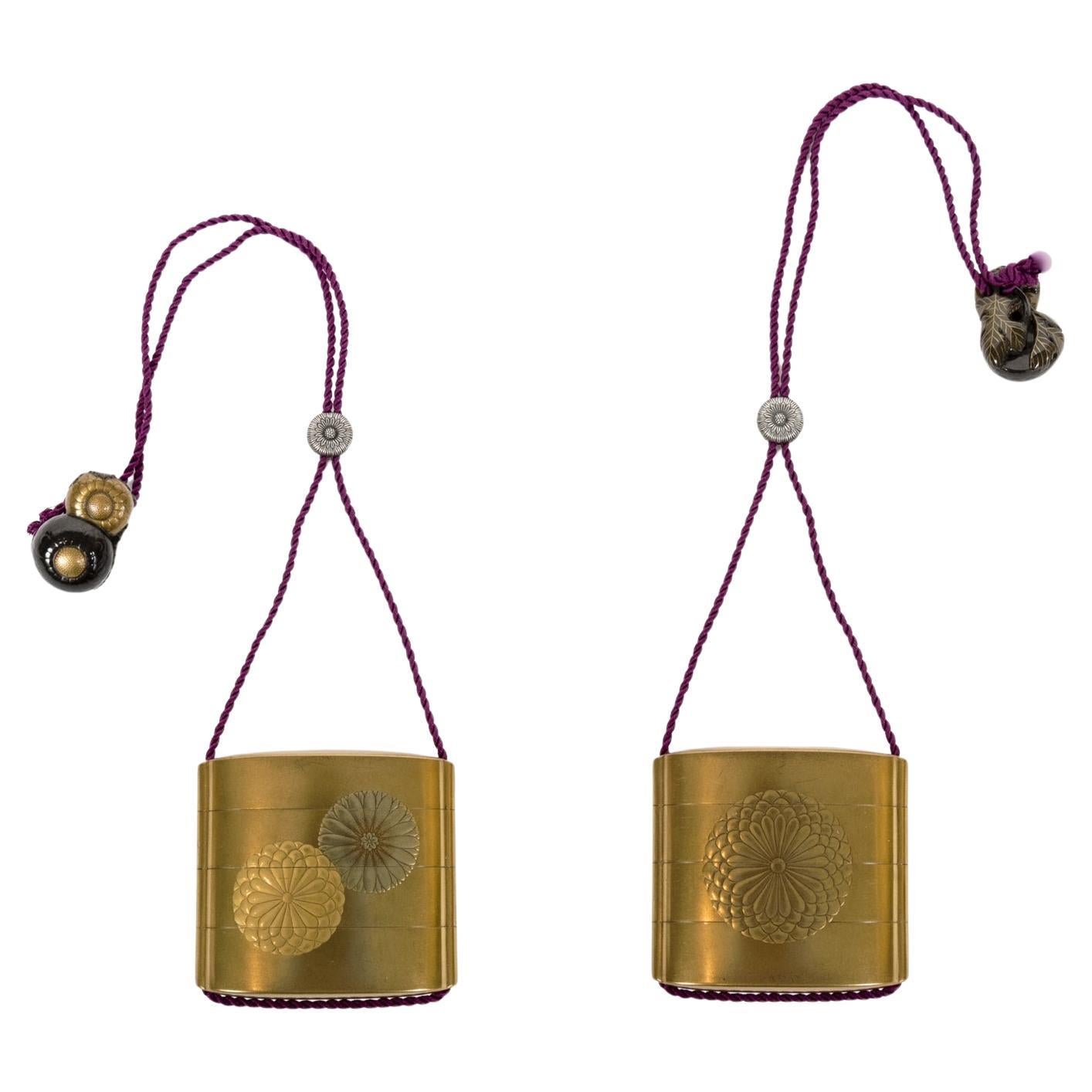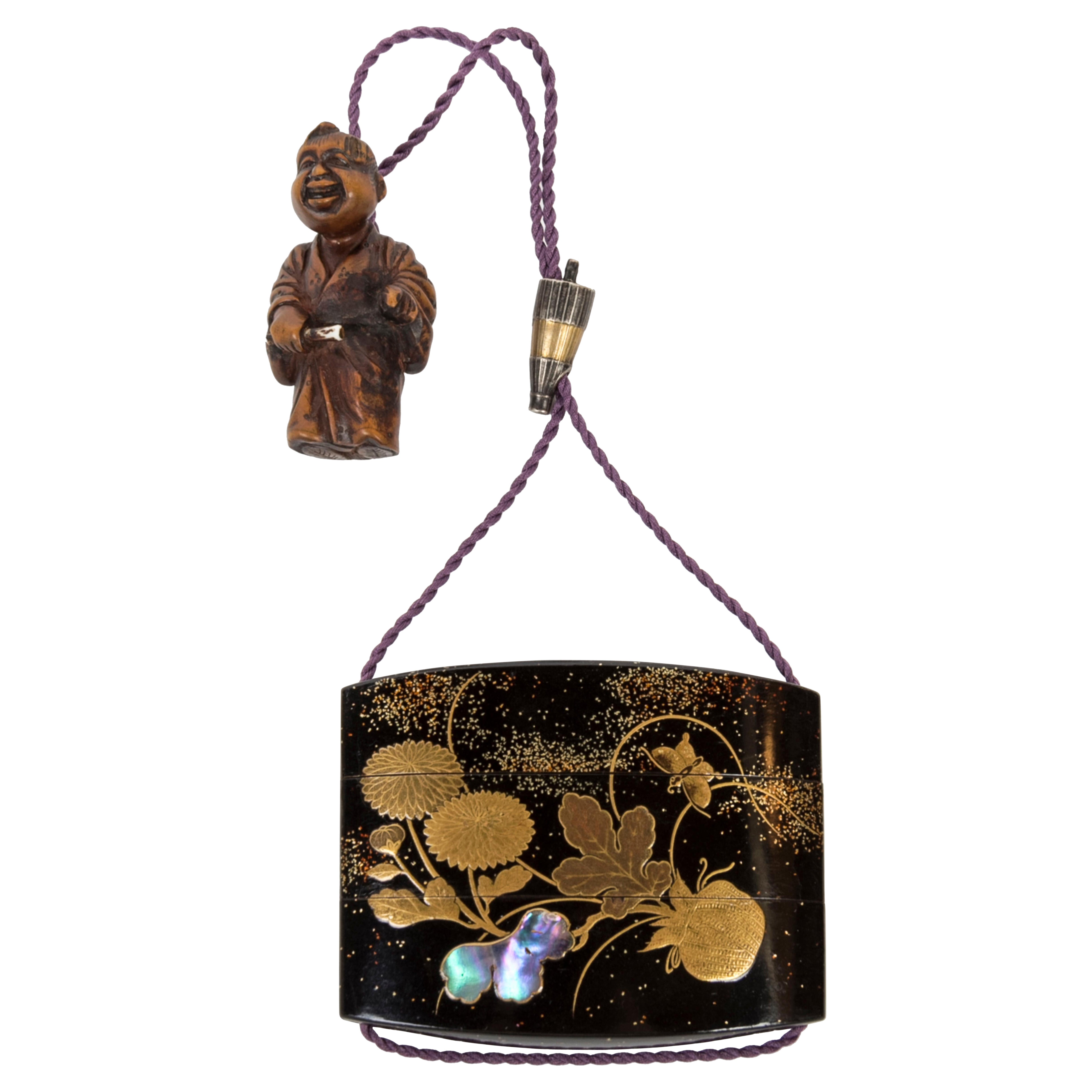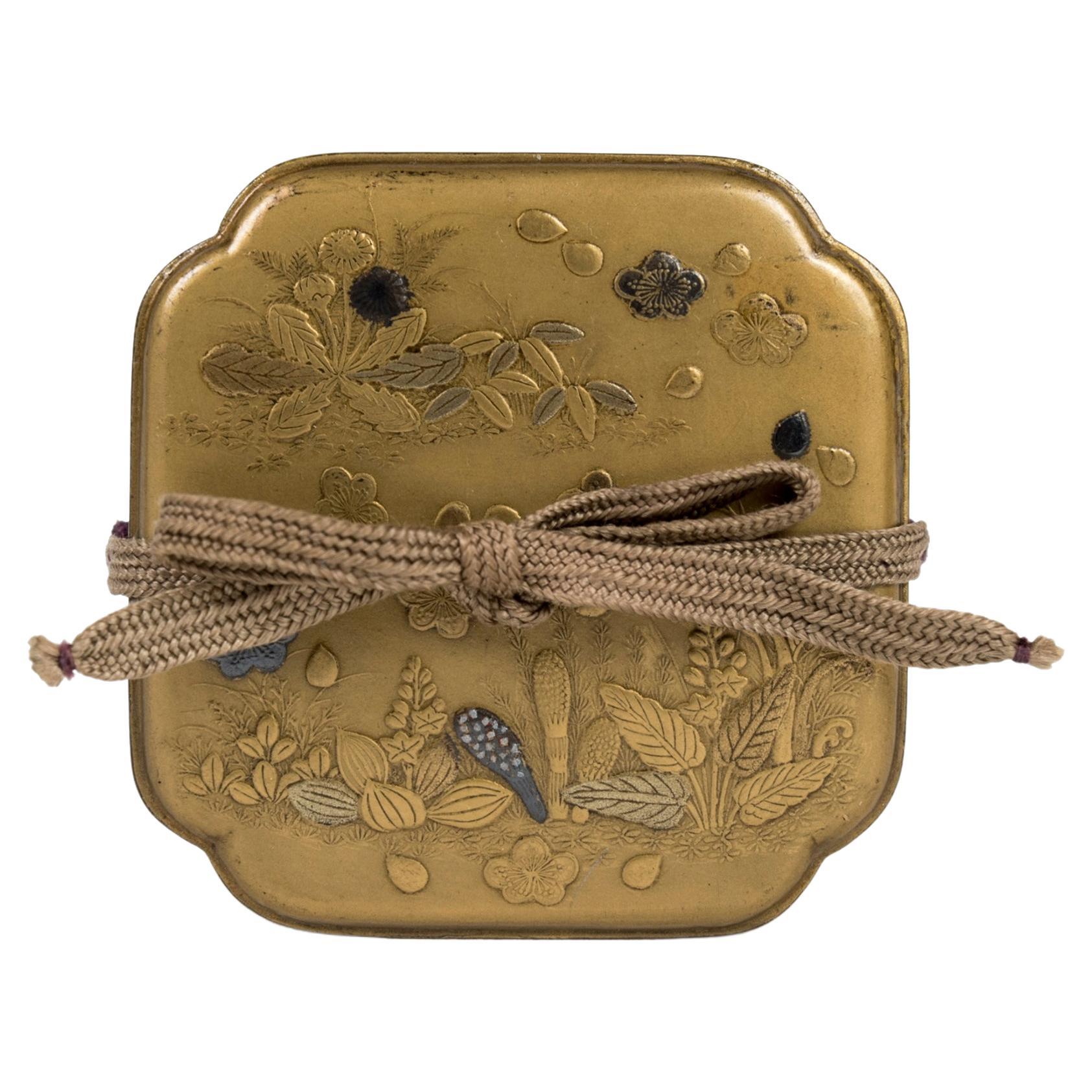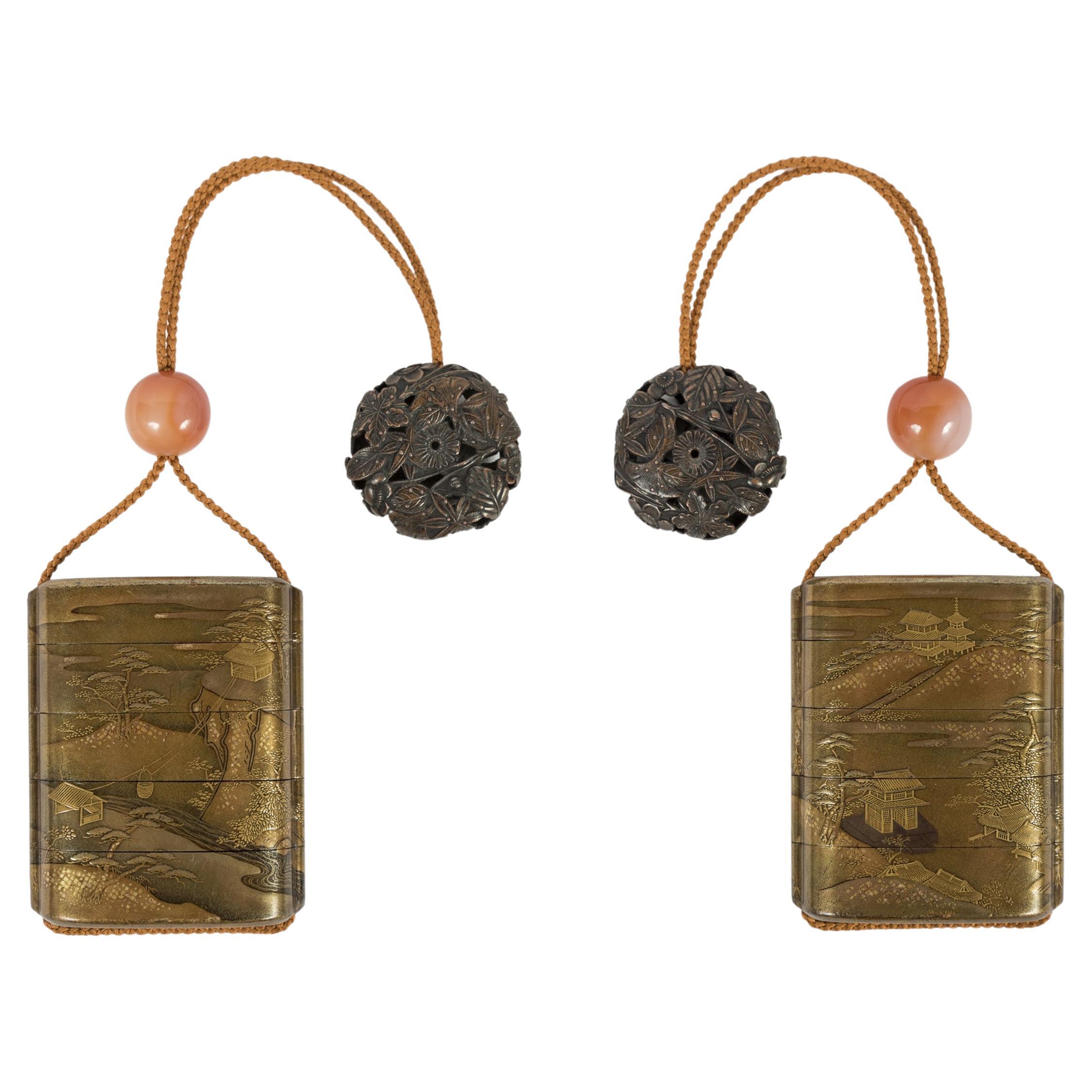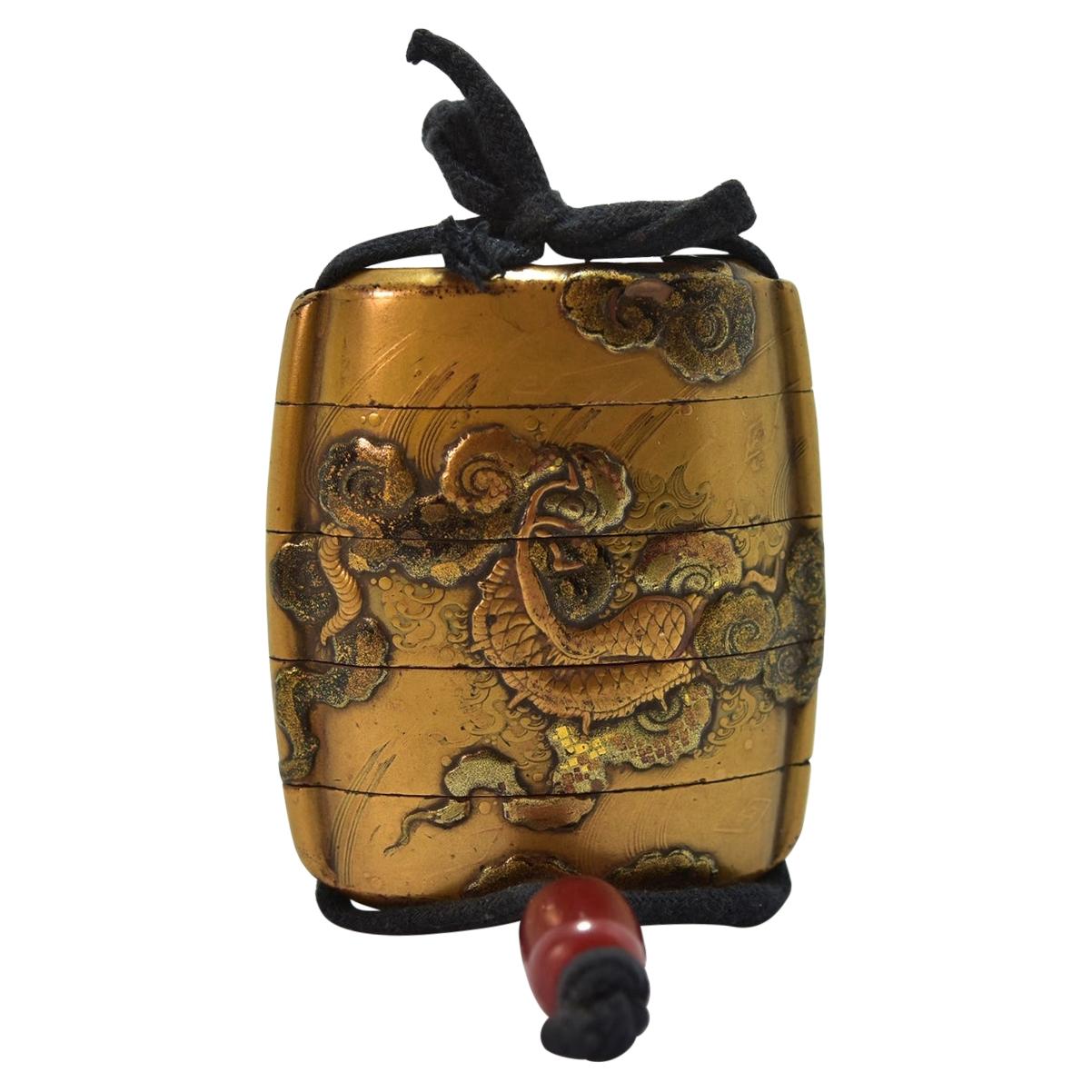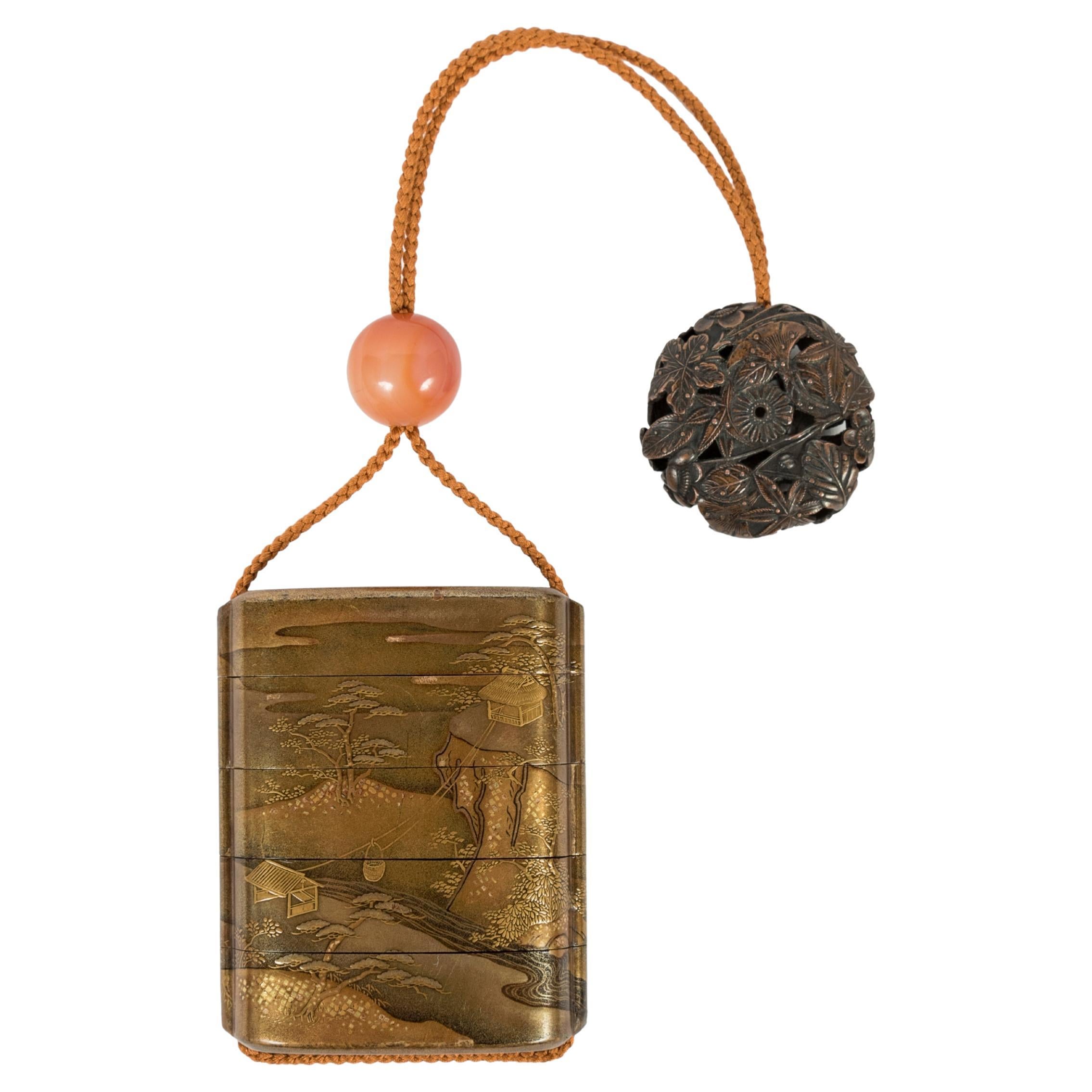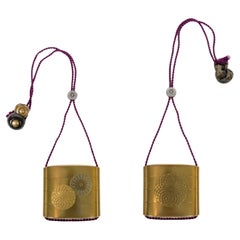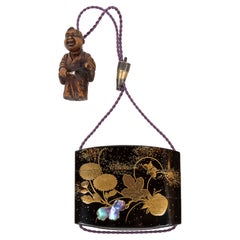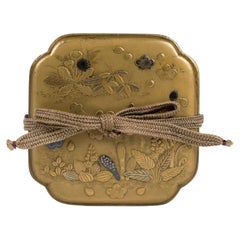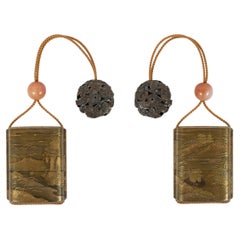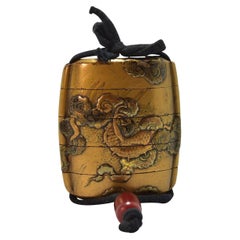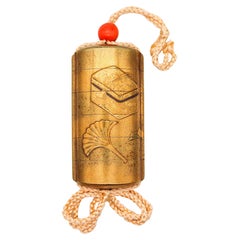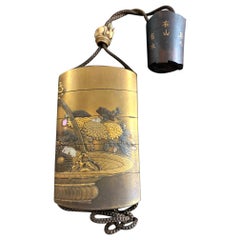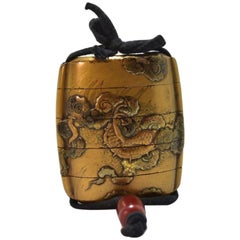Items Similar to Inro in gold kinji lacquer representing chrysantemum flowers on all sides
Want more images or videos?
Request additional images or videos from the seller
1 of 12
Inro in gold kinji lacquer representing chrysantemum flowers on all sides
$8,299.17
£6,211.03
€7,000
CA$11,449.43
A$12,732.24
CHF 6,687.25
MX$155,664.39
NOK 83,329.51
SEK 78,557.22
DKK 53,287.48
About the Item
Beautifull Inro of three compartments made in kinji lacquer with an hiro maki-e ornament chrysanthemum flowers of gold and silver lacquer. Inside is in fundame lacquer.
Signed by Josen Zo and stamped by Seisan
Presented with an Ojime in metal in the shape of a chrysanthemum flower and with its netsuke representing two chrysanthemum flower buds.
The chrysanthemum (kiku) in not only the heraldic symbol of the Japanese imperial family, it is also aflower with a complex history, still attached to the history of the Japanese isles. The flower is first described by Jacob Breynius in 1689, but it gets its name from Carolus Linnaeus that named it after : “Chrys” from the root of the grecque word meaning “golden”, and “Anthemon” which mean flower, chrysanthemum is litteraly the golden flower
Far from the baleful meaning it has in Europe, the chrysanthemum in Japan is overall a symbol of power, but also of longevity and happiness. The golden flower originated from China and arrived in Japan along the Nara period, for long it was only regarded as medicinal plant to cure and drop fever.
In order to understand the symbolism behind the flower we have to go back to 1500-1400 BCE. Chrysantemum were already cultivated in China at the time, mostly as an aromatic and decorative plant. It was already considered as a noble plant with mysterious power, a flower so important only the nobility was able to grow it in their garden. The same flower can be identified on some of the oldest Chinese porcelain.
It is only around the VIII th century that the chrysanthemum is introduced in Japan and risen to the status of national symbol. Later, the same flower will also be used as a model for the imperial signet.
Under the Heian era, the imperial family started to monopolize this symbol, by even creating a feast in its honour. On September 9th, or on the 9th days of the 9th month, the chōyō no sekku” festival is organized in Kamigamo sanctuary (Kyoto). After the ceremony of the chrysanthemum festival, a liturgic danse involving priests shooting bows and arrows while white raven costume take place. Which is then succeeded by an invitation to all children to compete in sumo wrestling inside the temple.
Even though this flower is well known over Japan for a long time now, it is only around the XIIIth century that the emperor Go-Toba choose to utilize the sixteen petaled chrysanthemum as its family crest. The heraldic of the chrysanthemum now represents all at once the emperor persona, the imperial family and the Japanese people. It is said that to honor former emperors their thrones were entirely covered in chrysanthemum flowers, originating the name of “Chrysanthemum thrones” to define the heir to Japan. Although formerly the appanage of the Japanese noble families, chrysanthemum growing became popular along the Edo period, originating from the imperial city o Kyoto. Numerous people dedicate their life to the selection and creation of new Chrysantemum varieties and expose their production in traditional family inn or among the numerous temples of Kyoto. All information, color, shape, name of the variety and even cost were conscientiously noted in a register. Even though it was essentially present in Kyoto, imperial city, between 1688 and 1703, the culture of chrysanthemum then spread all over Japan.
In addition, chrysanthemum is also one of the four “Junzi”, which a literal transation could be “member of nobility”. Prunus orchid bamboo and chrysanthemum are together “the four nobles”. Each one symbolizes a season: Winter for the Prunus, spring for the orchid, summer for the bamboo, and autumn for the chrysanthemum. This “Junzi” are still used in pictural art all around Asia.
This rich symbolism is among the reason we find the chrysanthemum flowers all around, on the Japanese passport, or on the 50-yen coin for example. Also, the supreme order of the Chrysantemum is still existing today and is the highest-ranking distinction that a Japanese citizen can receive, it is attributed by the emperor.
Chrysantemum is thus the only flower to be awarded such high regards.
Japan – Edo era (1603-1868)
Inrô : height: 7 cm – width 8 cm – depth : 2.5 cm
Netsuke : Length : 4 cm – width : 2.5 cm – depth 1.5 cm
Ojime : Diameter : 1.5 cm
- Dimensions:Height: 2.76 in (7 cm)Width: 3.15 in (8 cm)Depth: 0.99 in (2.5 cm)
- Style:Edo (Of the Period)
- Materials and Techniques:Lacquer,Lacquered
- Place of Origin:
- Period:
- Date of Manufacture:1603-1868
- Condition:Wear consistent with age and use.
- Seller Location:PARIS, FR
- Reference Number:Seller: 2024-13071stDibs: LU8311243629602
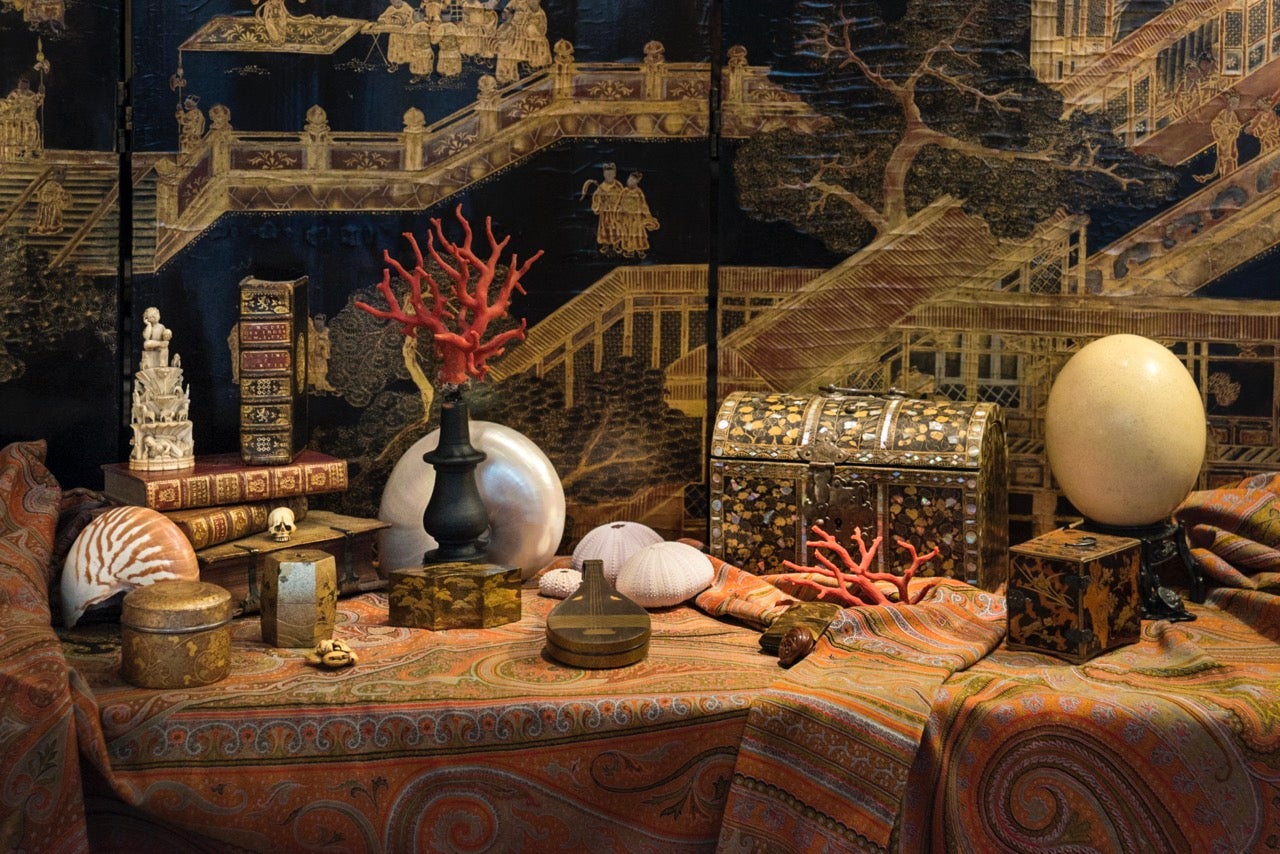
About the Seller
No Reviews Yet
Vetted Professional Seller
Every seller passes strict standards for authenticity and reliability
Established in 2013
1stDibs seller since 2023
- ShippingRetrieving quote...Shipping from: PARIS, France
- Return Policy
Authenticity Guarantee
In the unlikely event there’s an issue with an item’s authenticity, contact us within 1 year for a full refund. DetailsMoney-Back Guarantee
If your item is not as described, is damaged in transit, or does not arrive, contact us within 7 days for a full refund. Details24-Hour Cancellation
You have a 24-hour grace period in which to reconsider your purchase, with no questions asked.Vetted Professional Sellers
Our world-class sellers must adhere to strict standards for service and quality, maintaining the integrity of our listings.Price-Match Guarantee
If you find that a seller listed the same item for a lower price elsewhere, we’ll match it.Trusted Global Delivery
Our best-in-class carrier network provides specialized shipping options worldwide, including custom delivery.More From This Seller
View AllJapanese lacquered Inro chrysantemum
Located in PARIS, FR
Beautifull Inro of three compartments made in kinji lacquer with an hiro maki-e
ornament chrysanthemum flowers of gold and silver lacquer. Inside is in fundame
lacquer.
Signed by J...
Category
Antique Mid-18th Century Japanese Lacquer
Materials
Lacquer
Inro in black and gold lacquer with a proeminent chrysantemum flower motive
Located in PARIS, FR
Two compartments inrô in black lacquer, hira maki-e and mother-of-pearl inlay on a hirameiji background, decorated with a bouquet of chrysanthemums in a small purse, a hoe on the other side, and a fluttering butterfly which can be found on both sides. The interior is in hirameiji lacquer. The ojime is a drum made out of black lacquer and ivory with a mother-of-pearl inlay. The Manjû netsuke...
Category
Antique Mid-18th Century Japanese Edo Lacquer
Materials
Gold
Japanese golden kobako flowers Edo period 18th century
Located in PARIS, FR
Quadrangular kobako box decorated with flowers in gold and blue lacquer with aogai inlay. Lid and sides in fundame lacquer, underside and interio...
Category
Antique 18th Century Japanese Japonisme Lacquer
Materials
Gold
Gold Lacquer Inro Decorated with a Lake Landscape
Located in PARIS, FR
Inro with four gold lacquer boxes, decorated with a lake landscape. Accompanied by a bronze ryusa manju.
Small boxes formed of compartments that fit one on top of the other, inro (? ?) are traditional Japanese clothing...
Category
Antique Mid-19th Century Lacquer
Materials
Lacquer
Japanese inro of the edo period adorned with a landscape houses near a lake
Located in PARIS, FR
Inrō with four gold lacquer compartments, decorated with a lake landscape. Accompanied by a bronze ryusa manju.
Small boxes formed of compartments that fit one on top of the other, i...
Category
Antique Late 18th Century Japanese Edo Lacquer
Materials
Gold
Japanese Sagemono Inro box with a maki-e decor of a Samuari in a lake landscape
Located in PARIS, FR
Inrô in gilded lacquer according to the takamaki-e, hiramaki-e and kirigane techniques, with five squares of a mountain lake landscape.
On the first side, there is a man on horsebac...
Category
Antique 18th Century Japanese Edo Lacquer
Materials
Gold
You May Also Like
Japanese Inro with 4 Boxes in Gold Lacquer with Mat Kinji Background
Located in Marseille, FR
19th century Japanese inro with 4 boxes in gold lacquer with kinji mat background decorated in taka makiyé of gold of different tones. Lacquered wood siz...
Category
Antique 19th Century Japanese Japonisme More Asian Art, Objects and Furn...
Materials
Giltwood
Japan 1800 Edo Period Six Drawer Inro In Lacquered Gilt Wood With Utensils
Located in Miami, FL
Japanese Inro from the Edo Period (1603-1867).
Beautiful Inro, created in Japan during the Edo period (Shogunate), circa 1800. It was carefully crafted in carved precious wood with ...
Category
Antique Early 1800s Japanese Edo Lacquer
Materials
Coral
$2,275 Sale Price
30% Off
Antique Japanese Inro by Shigehide Edo Period
Located in Atlanta, GA
This exquisite four-case lacquered inro was dated to the latter part of 18th century to early 19th century (Edo period) and made by Shigehide. The opposite sides of the inro together features a lavish flower arrangement in a bamboo basket (ikebana). The detailed craftmanship was a true pleasure to behold. Mostly Takamaki-e (high relief) were used to texturize the delicate petals of the chrysanthemums, on which different shades of gold were used to create contrast. Raden (mother of pearl) shells were also used to highlight some leaves, rendering the piece an interesting balance of color and material. The interior was completed in a mottled gold finish. It was signed Shigehide on the bottom with a Kao. There is a small carved rabbit ojime bead...
Category
Antique Late 18th Century Japanese Japonisme Lacquer
Materials
Wood, Lacquer
Japanese Inro with 4 19th Century Boxes in Gold Lacquer with Matt Kinji Backgrou
Located in Marseille, FR
Japanese inro with 4 XIXth century boxes in gold lacquer with matt kinji background decorated in gold taka makiyé of different tones. Lacquered wood measuring 65 x 70 x 22 mm. Weight...
Category
Antique 19th Century Japanese Snuff Boxes and Tobacco Boxes
Materials
Lacquer
Lacquer inro, Japanese, Late 19th c.
Located in Stockholm, SE
A fourpart Japanese lacquer Inro. the lacquer is red with motives of a spider with its web in gold and two flying cranes. The lowest part of the inro has a crack on one side.
Category
Antique Late 19th Century Japanese Lacquer
Materials
Lacquer
Japanese Lacquered Gold Maki-E Naga Fubako Meiji Period
Located in Atlanta, GA
A Japanese lacquered wood Naga Fubako (a long box used to store document or large scroll painting), circa 19th century Meiji period. The rectangular box features an unusually deep lipped lid with slightly rounded corners, a conforming lower box with bronze medallion rings with tasseled...
Category
Antique 19th Century Japanese Meiji Lacquer
Materials
Wood, Lacquer
More Ways To Browse
White Lacquer Furniture
Antique Invitations
White Lacquer Asian
Temple Lacquer
The Four Seasons 19th Century
Throne Cover
Temple Ornament
Japanese Garden Ornaments
Four Seasons Silver
Bow China
Netsukes
Asian Root Furniture
Silver Throne
Antique Chinese Coins
Japanese Family Crest
Garden China Made In Japan
Chinese Throne
Prunus Porcelain
